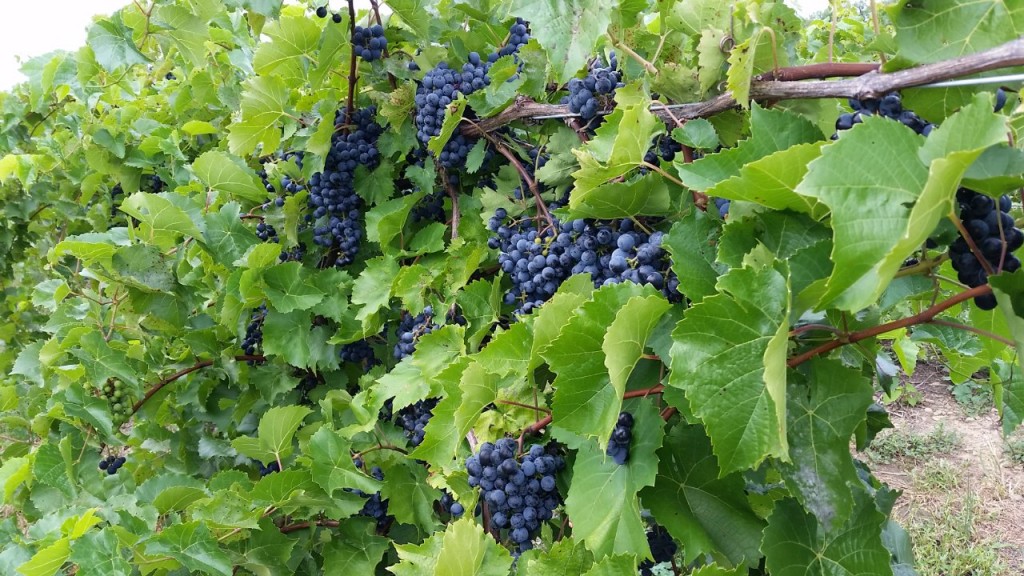2017 Harvest Update: September 29th
 We’re in the middle of harvest now, and in a bit of a lull in the pressing schedule. It will be short-lived though —a day or two and we’ll be back working with the late season varieties in full force. But this gives us a moment to look at how the harvest has been to date, and what the outlook is for the remaining weeks.
We’re in the middle of harvest now, and in a bit of a lull in the pressing schedule. It will be short-lived though —a day or two and we’ll be back working with the late season varieties in full force. But this gives us a moment to look at how the harvest has been to date, and what the outlook is for the remaining weeks.
The big news so far is the weather and how many consecutive times the good side of the coin has come up for the grapes. The last several weeks have been hot and dry, with a lot of sun. The temperatures have been in the 80’s for the most part, which is ideal for giving the vines a huge boost to ripen the fruit. Fall heat can also nudge molds and mildews into gear, though, if there is enough moisture to get them going. And that’s been the beauty of this weather pattern: ample dry air and sun has kept these undesirables at bay, allowing the grapes to reach nice maturity while avoiding rot.
One grower observed that despite the dry conditions with no rain for several weeks, he’s had to mow the grass every week, and the only brown spots were where the tractor has been driven on it. This is because of another aspect of the weather: cool clear nights that produce a heavy dew by morning. Not only has this kept the grass green, but it has also provided just enough moisture to the vines to allow them to continue the ripening process without stress. The dew dries up by mid-morning, keeping disease from taking serious hold. All of this has given us a stellar harvest period to date, for the most part offsetting the less than ideal conditions of the earlier part of summer. The pattern has now changed to one that is more typical for us this time of year: temperatures are in the 60’s, but we are still having a lot of sun in the forecast. Late-season varieties will continue to ripen, and molds and mildews will continue to be held in check. All puppies and rainbows for the grapes at the moment.
Ripeness can be assessed and measured in several ways. First is sugar content, measured in °Brix”. This is the most common metric in the American Industry (other countries use different scales, or scales that also relate to potential alcohol). Sugar accumulation in grapes is a function of photosynthesis, and ample sunlight, adequate moisture, and leaves that are not disease-damaged are needed for maximum sugar levels. These conditions are all in place so far this year and varieties harvested in the last week have shown nice increases in sugar content to normal and typically better than normal brix.
Acid content, measured as either total acid (in g/L or %) or pH, is another important way of assessing the ripeness of the grapes. There are two primary acids found in grapes: tartaric and malic. As berries mature, tartaric acid remains at a fairly constant level while malic acid is transpired by the vine, lowering the acid content. The degree of acid metabolization by the vine is dependent on heat, and in a cool year, we see less malic acid transpiration and thus higher acid levels. This is what we are seeing in some varieties this year, especially the earliest ones because of the cooler conditions seen earlier in the season. Later varieties with longer exposure to the sun and heat are finally getting down to normal acid levels.
The final measure of ripeness and by far the most important: flavor. As a winemaker, I can adjust both sugar and acid level with reasonable results. It is much more difficult to make flavor adjustments that are successful. Unripe fruit simply lacks flavor, and we can’t just add it from another source. We are kind stuck with what we get. One of the keys for our area in terms of developing flavor in berries is being able to let them hang on the vine long enough for the ripe flavors to develop. At the risk of sounding like a broken record, this requires ample sunlight, adequate moisture and leaves that are not disease-damaged. And yes, this is what we are seeing in the varieties that have been on the vines through this period. Nice, ripe flavors are showing up with a vengeance.
The upcoming week will have us back in the vineyard taking samples, trying to determine when to harvest each variety and block. In the meantime, we’ll be monitoring wines fermenting in the winery, and keeping the caps on the fermenting reds punched down. Some of them will be pressed mid-week and will soon be ready for those of you looking to purchase them as Young Wines.
Bob Green
PIWC Executive Winemaker


